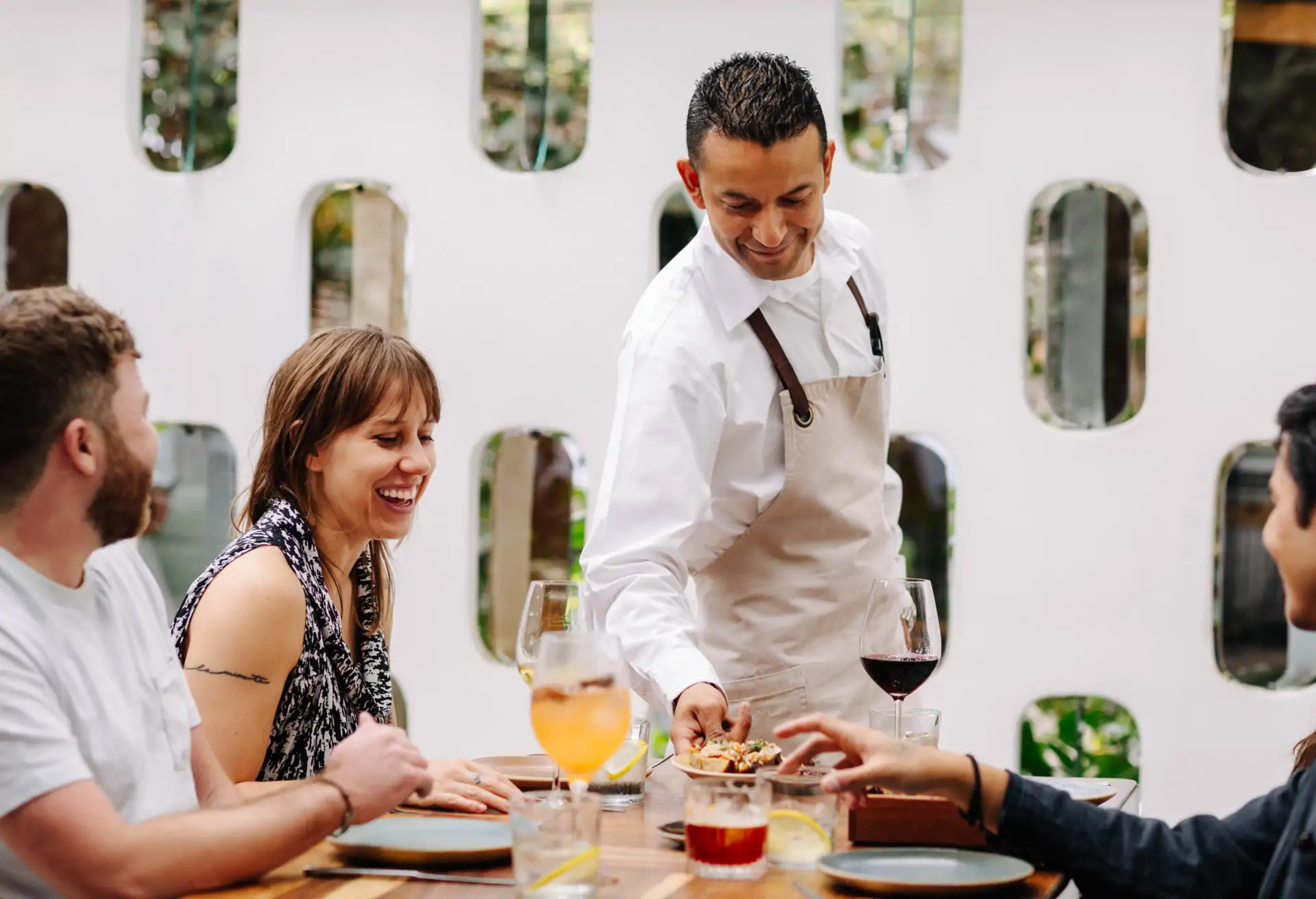Restaurants thrive on relationships. Guest relationship management (GRM) brings the principle to life, putting meaningful interactions at the center of your operations. When you recognize returning guests or remember their preferences, you can create personalized moments and build the kind of loyalty that directly impacts your restaurant’s success.
What is guest relationship management?
Guest relationship management goes beyond knowing your regulars by name. It helps restaurants collect and use guest data to deliver more personalized service and marketing. While traditional hospitality has always valued guest connections, modern tools now help restaurants understand guest preferences on a deeper, more personalized level.
You can create stronger connections with customers at every step of their journey. From first impressions to post-visit follow-ups, the goal is to make guests feel valued and understood—so that they come back again and again. Restaurants that gather insights about dining preferences and feedback can enhance their service in ways that create truly memorable experiences.
Many restaurants already practice some form of relationship management, like when servers remember a regular’s favorite wine or hosts note preferred seating in their guestbook. Using tools for guest relationship management professionalizes the practice, putting guests front and center of every conversation.
What’s the difference between GRM and CRM?
It’s easy to confuse guest relationship management with customer relationship management systems (CRMs). While they share similar goals, there’s an important distinction: traditional CRMs were built for businesses selling products, not experiences. Restaurant guest relationship management focuses specifically on the unique needs of hospitality businesses.
A good GRM offering is designed around the guest experience. It integrates with reservation systems while tracking important guest preferences. Unlike generic CRMs, restaurant-focused platforms include hospitality features such as pre-shift reports that highlight VIPs before service begins. Having a tailored approach helps you deliver the kind of personalized attention that builds genuine connections with your guests.
Why guest relationship management matters
Your regulars make your restaurant tick. They spend more, come in more often, and bring friends along when they visit. Good guest relationship management helps you recognize and reward these valuable guests and gives them reasons to choose your restaurant over another spot time and again.
When a host warmly greets guests by name or a server remembers their favorite wine without any prompting, people feel valued. It’s those personal touches that create the kind of emotional connections that keep guests coming back instead of trying the new place down the street. In an industry where margins are tight, building loyalty is good hospitality.
Retention marketing with guest relationship management
Bringing past guests back is one of the best moves any restaurant can make. Returning guests typically spend more and cost less to reach than brand-new customers.
Good retention marketing helps with this, using what you know about guests to tailor communications so that they feel personal. For example, an email announcing that the seasonal dish they ordered last year is back on the menu will perform better than a generic announcement.
Every time a guest returns, you gather more insights that make your next outreach even more engaging. What you get as a result is a natural cycle of better guest relationships and increased revenue. For restaurants focused on long-term success, turning occasional visitors into regulars simply makes good business sense.
Does guest relationship management enhance your brand?
A great reputation isn’t built on food alone, and when guests feel personally recognized, they connect with your restaurant on a more meaningful level. Personalized service creates a distinctive identity and helps you stand out in a sea of dining options.
Happy guests become your most convincing marketers. They post about their experiences on social media and spread the word in conversations with their friends and family. Authentic publicity drives new business far more effectively than traditional advertising, to the point that word-of-mouth marketing is ten times more effective than traditional advertising.

How to do guest relationship management right?
Many successful restaurants begin with simple approaches that focus on gathering important information and making it accessible to staff. As your efforts grow, you can add tools to expand your capabilities. The key is consistency and having reliable processes that work for your particular restaurant.
Collect meaningful data
Start by gathering information that helps you provide better service. Beyond basics like contact details, note dietary restrictions and seating preferences. Pay attention to ordering patterns and feedback. Every interaction provides an opportunity to learn something valuable about your guests that you can use to make their next visit even better.
Make information accessible
Guest data only helps when your team can actually use it. Create a culture where gathering guest data is front and center of everything you do. Build guest profiles and create pre-shift reports that help staff prepare for VIPs and special celebrations before each service. That way, nobody misses an opportunity to deliver personalized hospitality.
Be thoughtful in your communications
Building relationships continues beyond the dining room. Email marketing lets you stay connected with guests between visits, but quality matters more than quantity. Send messages that offer genuine value, be it a one-time email send about a special event, an automated campaign with an exclusive offer to a loyal guest celebrating their birthday, or a text message to confirm preferences. These personalized communications will make a bigger impact than generic messages.
For instance, OpenTable data shows that restaurants using the email marketing feature generate an average of $700 in sales per month.* Targeted communications are remarkably effective, with open rates over 15% higher than industry standards and click rates more than double the average for dining and food services.
Respond to feedback
Guest feedback provides invaluable insights about what your restaurant is doing well, but most importantly, how it can do even better. Reputation management tools help you monitor and respond to reviews across platforms like Google and Facebook. Addressing both positive and negative comments shows guests you value their input.
OpenTable’s AI-powered tools also save valuable time. Restaurants using assisted response features can respond to reviews in half the time,** while ones with Premium Communications get guest responses nearly 40% faster.***
Be proactive, not reactive
Don’t wait for guests to identify themselves as regulars before you start building relationships. Spot potential VIPs early, and think of those first-time visitors who ordered premium wines or guests celebrating special occasions. Following up with a personalized message or special offer after their initial visit can turn a one-time guest into a regular.
Train your staff to notice and record guest preferences during service. Something as simple as a host noting that a guest prefers quiet tables or a server remembering someone’s favorite cocktail can make a lasting impression. When the entire team actively contributes to your guest knowledge base, you create a detailed view of each guest that improves with every visit.
Guest relationship management tools that make the difference
Guest relationship management starts with those all-important interactions between your staff and guests. But tapping into restaurant technology makes relationship management even more impressive. OpenTable’s guest relationship management centralizes your guest data, giving your entire team access to richer guest insights—from favorite dishes and seating preferences, to spend history, and even social profiles—powered by the largest diner network and partner integrations. Having a comprehensive view helps staff deliver consistently personalized service that builds stronger connections.
The most effective systems combine guest intelligence with practical, customizable communication tools.
- Pre-shift reports alert your team to VIPs and celebrations before service begins.
- Automated tags help identify high-value guests without manual work.
- Email marketing lets you reach out to past guests with relevant messages based on their interests and dining behavior.
When these capabilities work together, they create a frictionless experience that makes guests feel valued at every touchpoint. Restaurants using OpenTable Pro see nearly 30% higher check sizes per person compared to those on basic plans.****
Making every guest feel like a VIP
At its core, guest relationship management combines thoughtful service with smart systems that help you know your guests better. When you remember the important details, you create the kind of memorable experiences that keep people coming back. In a business built on relationships, these connections are what truly set successful restaurants apart.
*Based on average monthly revenue restaurants generated from OpenTable email campaigns in 2024
**Based on the change in response time among restaurants that use OpenTable assisted review responses vs. those that do not
***Based on guest response times among restaurants with and without OpenTable Premium Communications
****Based on 2024 average per person check sizes among restaurants on Core and Pro plans




